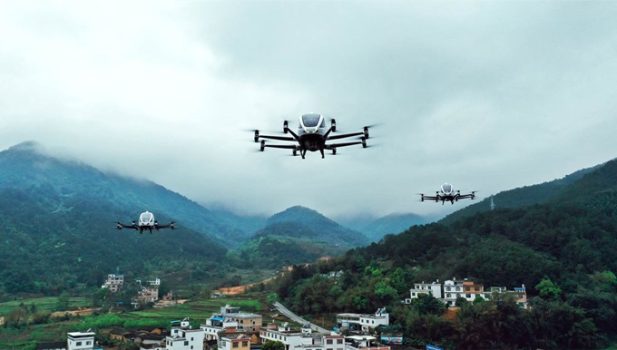 Pin
Pin Photo courtesy of EHang
China has made a groundbreaking move by approving pilotless flying taxis for commercial use. This development is not just a futuristic dream—it’s happening now. The country has been a leader in technological advancements, and now, it’s pushing boundaries in the aviation sector. With this approval, China becomes one of the first nations to bring autonomous aerial vehicles (AAVs) into mainstream transportation.
The introduction of flying taxis in China could transform urban mobility. These vehicles aim to reduce congestion on the roads and provide a faster, more efficient way to travel. Unlike traditional helicopters, they operate autonomously, meaning no pilots are required. Companies like EHang have been leading the charge, showcasing their capabilities through successful test flights.
Safety remains a major focus, and regulators have imposed strict guidelines to ensure reliability. While skepticism exists, the technology behind these flying taxis is robust. With real-world implementation underway, the dream of flying above city traffic is now a reality.
Table of Contents
EHang's Milestone: Pioneering Mass Production of Pilotless Air Taxis
 Pin
Pin Photo courtesy of EHang
In a groundbreaking development, EHang Holdings Limited has secured the world’s first production certificate for its EH216-S pilotless electric vertical takeoff and landing (eVTOL) aircraft. This certification, granted by the Civil Aviation Administration of China (CAAC), marks a pivotal moment in the eVTOL industry, enabling EHang to transition from prototypes to mass production. The EH216-S is designed to carry two passengers without a pilot, aiming to revolutionize urban air mobility by offering autonomous, eco-friendly transportation solutions. EHang’s CEO, Hu Huazhi, emphasized the company’s vision to introduce safe and reliable pilotless eVTOL aircraft to the global market, highlighting the potential to transform urban transportation dynamics.
The EH216-S boasts a carbon fiber fuselage and 16 propellers powered by individual motors, achieving a cruise speed of 62 mph and a maximum altitude of approximately 10,000 feet. Its autonomous navigation system eliminates the need for onboard pilots, representing a significant advancement in unmanned aerial vehicle technology. EHang has conducted extensive testing, including both crewed and uncrewed flights, to validate the aircraft’s safety and reliability. The mass production of the EH216-S is expected to pave the way for its deployment in various sectors, including air taxi services, aerial tourism, and emergency response operations.
This milestone aligns with China’s broader strategy to develop its low-altitude economy, with plans to integrate 100,000 flying cars into its cities within the next six years. The initiative aims to establish comprehensive air traffic networks and ground facilities to support the widespread adoption of eVTOLs. While current models are costly, advancements in technology and mass production are anticipated to make these vehicles more accessible by 2030. The focus remains on ensuring safety and regulatory compliance, with measures such as anti-drone technologies and designated no-fly zones being implemented to facilitate the seamless integration of flying taxis into urban environments.
China's Regulatory Approval: A Catalyst for the Global eVTOL Industry
China’s recent approval of pilotless flying taxis for commercial use marks a significant milestone in the evolution of urban air mobility. The Civil Aviation Administration of China (CAAC) has granted air operator certificates to EHang Holdings and Hefei Hey Airlines, allowing them to operate autonomous passenger drones for services such as urban sightseeing tours. This regulatory green light is not just a win for these companies but sets a precedent for the global eVTOL (electric vertical takeoff and landing) industry, potentially influencing regulatory frameworks worldwide.
The approval underscores China’s commitment to integrating advanced technologies into its transportation infrastructure. By embracing autonomous aerial vehicles, China aims to alleviate urban congestion and reduce carbon emissions, aligning with broader environmental goals. This move also positions China as a leader in the burgeoning field of urban air mobility, potentially inspiring other nations to expedite their regulatory processes to keep pace.
However, the path forward involves addressing several challenges, including public acceptance, air traffic management, and stringent safety protocols. The successful deployment of pilotless flying taxis in China will serve as a critical case study for other countries contemplating similar initiatives. As the global community watches closely, China’s experience may offer valuable insights into the practicalities of integrating autonomous aerial vehicles into existing transportation ecosystems.
Challenges and Opportunities in China's Flying Taxi Revolution
China’s approval of pilotless flying taxis for commercial use is undeniably groundbreaking, but the journey ahead is filled with both challenges and opportunities. One of the primary concerns is public acceptance. Convincing the masses to trust and adopt this new mode of transportation requires extensive education and transparent communication about safety measures and benefits. Additionally, integrating these autonomous aerial vehicles into the existing urban infrastructure poses logistical challenges. Establishing vertiports, ensuring efficient air traffic management, and creating emergency protocols are essential steps that need meticulous planning and execution.
On the flip side, the potential benefits are immense. The successful implementation of flying taxis could significantly reduce urban traffic congestion, lower carbon emissions, and revolutionize the concept of commuting. Moreover, it positions China at the forefront of the eVTOL industry, potentially setting a global standard for urban air mobility. Companies like EHang and Hefei Hey Airlines are not only pioneers in technology but also in navigating the complex regulatory and societal landscape that comes with such innovations.
As China embarks on this ambitious journey, the world watches with keen interest. The lessons learned, challenges faced, and successes achieved will undoubtedly provide valuable insights for other nations contemplating similar ventures. The era of flying taxis is no longer a distant dream but a burgeoning reality, and China’s proactive approach may well dictate the pace and direction of this exciting new frontier in transportation.
Safety and Regulation: Ensuring a Secure Future for Flying Taxis
China’s approval of flying taxis brings both excitement and concerns. One of the biggest questions is: how safe are these autonomous aerial vehicles? While companies like EHang have conducted thousands of test flights, safety remains a priority. The Civil Aviation Administration of China (CAAC) has imposed strict regulations, requiring thorough testing, redundancy systems, and continuous monitoring to prevent accidents. Unlike traditional aircraft, these eVTOLs rely on electric propulsion and sophisticated AI-driven navigation systems, which must be rigorously tested for reliability.
Air traffic control for flying taxis is another challenge. Unlike roads, the sky has no physical lanes, making traffic management crucial. China is developing an advanced air traffic management system that integrates AI and real-time tracking to ensure smooth operations. No-fly zones, emergency landing protocols, and automated rerouting systems will play a key role in maintaining safety. Similar to self-driving cars, these aerial vehicles need failsafe mechanisms to handle unexpected weather changes or technical malfunctions.
Additionally, public trust must be earned. Many people remain skeptical about stepping into a pilotless flying machine. To address this, authorities and companies are focusing on public education campaigns, transparency in safety reports, and real-world demonstrations. If China successfully proves the reliability of these flying taxis, it could set a global precedent, encouraging other nations to follow suit. The future of urban aviation hinges on making these vehicles as safe and dependable as commercial airplanes.
How Flying Taxis Could Transform Industries
The approval of flying taxis in China isn’t just about futuristic transportation—it’s also a major economic opportunity. The emerging eVTOL (electric vertical takeoff and landing) industry is expected to create thousands of jobs, ranging from engineers and software developers to maintenance crews and air traffic controllers. As mass production ramps up, companies like EHang will require a skilled workforce to manufacture, operate, and maintain these advanced aircraft.
Beyond job creation, the commercial use of flying taxis opens up new business models. Urban air mobility could disrupt the traditional taxi and ride-sharing industries. Instead of sitting in hours of traffic, passengers could book a flying taxi through an app and reach their destination in minutes. Tourism is another sector that stands to benefit. Sightseeing tours using aerial taxis could offer unique, breathtaking views of cities and landmarks, attracting high-end travelers willing to pay for the experience.
Logistics and emergency response services could be revolutionized. Autonomous flying vehicles could be used for medical transport, delivering organs or emergency supplies quickly to hospitals. In disaster situations, these vehicles could provide rapid evacuation or relief efforts in areas inaccessible by traditional means. With China leading the charge, other countries might soon follow, making the flying taxi industry a major economic driver worldwide.
Public Reaction: Excitement, Skepticism, and the Future of Urban Air Travel
The announcement of commercial flying taxis in China has sparked a mix of excitement and skepticism among the public. For tech enthusiasts, this marks a futuristic breakthrough—one step closer to the sci-fi vision of cities with flying cars. Many people see it as a solution to urban congestion, allowing commuters to skip traffic jams and travel more efficiently. The idea of booking a flying taxi with just a few taps on an app feels like a natural evolution of ride-sharing services.
However, not everyone is convinced. Safety concerns remain a major topic of discussion. While companies like EHang emphasize their rigorous testing and compliance with aviation regulations, many people are still uneasy about stepping into a pilotless aircraft. What happens if there’s a system failure? How will these vehicles navigate in bad weather? These are the kinds of questions that skeptics continue to raise. Convincing the general public will require not just strong safety measures, but also real-world proof that flying taxis can operate reliably without incidents.
There’s also the issue of affordability. Right now, flying taxis are expected to be a premium service, accessible mainly to high-income passengers. Many wonder when—or if—these vehicles will become affordable for the average commuter. As technology advances and production scales up, costs are likely to drop, but widespread adoption could still take years. If flying taxis are to become a true game-changer, they’ll need to be accessible to more than just the wealthy elite.
How China’s Move Could Influence Other Countries
China’s approval of pilotless flying taxis isn’t just a national milestone—it has global implications. As one of the first countries to officially greenlight commercial autonomous aerial vehicles, China is setting a precedent for the rest of the world. Other nations are now watching closely to see how successful this rollout will be. If China can demonstrate that flying taxis are safe, efficient, and economically viable, other governments may be more inclined to accelerate their own regulatory approvals.
Countries like the United States, the United Kingdom, and Germany have already been exploring eVTOL technology, but strict aviation regulations have slowed down commercial adoption. The Federal Aviation Administration (FAA) in the U.S. and the European Union Aviation Safety Agency (EASA) have been conducting studies on integrating eVTOLs into urban airspaces, but no country has moved as quickly as China in granting commercial certification. If China proves the concept works, it could pressure other regulatory bodies to catch up or risk falling behind in the urban air mobility race.
China’s leadership in flying taxis could shift the competitive landscape of the aviation industry. Traditionally, companies like Boeing and Airbus have dominated global aerospace, but firms like EHang are now gaining international recognition. If Chinese flying taxis become the first to operate at scale, it could lead to increased exports, technology partnerships, and even influence how cities worldwide plan their future transportation networks. This move isn’t just about making travel faster—it’s about shaping the future of aviation.
The Road to 2030: What the Future Holds for Flying Taxis
China’s approval of pilotless flying taxis is just the beginning. Over the next decade, we can expect rapid advancements in technology, infrastructure, and policy that will shape the future of urban air mobility. By 2030, flying taxis could be a common sight in major Chinese cities, transporting passengers, goods, and even emergency medical supplies. The key to this transformation will be scaling up production, improving battery technology, and refining autonomous navigation systems to make these vehicles safer and more efficient.
Infrastructure development will be a crucial factor. Cities will need designated landing zones, known as vertiports, to accommodate flying taxis. These could be built on top of skyscrapers, transportation hubs, or even floating platforms. Traffic management systems will also have to evolve to coordinate the movement of these aerial vehicles. China’s plan to integrate flying taxis into a broader “low-altitude economy” suggests a long-term vision where air travel becomes as routine as ground transportation.
Another major question is affordability. Right now, flying taxis are positioned as a luxury service, but as production costs decrease, they could become accessible to the general public. If technological advancements lead to cheaper, more energy-efficient aircraft, we might see a future where aerial commuting is as affordable as taking a train or bus. While challenges remain, one thing is clear—China has taken the first major step, and the rest of the world is now paying attention.
A New Chapter in Urban Transportation
China’s decision to approve pilotless flying taxis for commercial use marks a bold step into the future. What was once science fiction is now a tangible reality, with autonomous aerial vehicles preparing to take flight in major cities. While challenges like safety, infrastructure, and public trust still need to be addressed, the progress made so far is undeniable. If successful, this could revolutionize the way we think about transportation, reducing traffic congestion and cutting travel times significantly.
The ripple effect of this innovation could extend beyond China. Other countries may soon follow suit, either by developing their own eVTOL systems or by partnering with Chinese firms to bring the technology to their cities. The global aviation industry is watching closely, knowing that the success or failure of these pilotless flying taxis will influence future regulatory decisions worldwide.
As we stand on the edge of this transformation, one thing is certain—the skies are no longer just for traditional airplanes. Urban air mobility is here, and China is leading the charge. Whether flying taxis become an everyday mode of transport or remain a premium service for the elite, their arrival signals the beginning of a new era in transportation. The coming years will determine just how high this innovation can soar.
FAQs
Pilotless flying taxis, also known as eVTOL (electric vertical takeoff and landing) vehicles, use electric propulsion and autonomous navigation systems to transport passengers without a human pilot. These vehicles rely on AI, GPS, and real-time monitoring to ensure safe and efficient flights.
Yes, safety is a top priority. Companies like EHang have conducted thousands of test flights under strict aviation regulations. These taxis are equipped with backup systems, AI-driven navigation, and emergency landing protocols to ensure passenger safety. Regulatory bodies, such as the Civil Aviation Administration of China (CAAC), have imposed rigorous safety standards before approving them for commercial use.
China has already granted approval for commercial pilotless flying taxis, with initial operations focused on tourism and urban transportation. While large-scale public use may take a few more years, experts predict that by 2030, these vehicles could become a common mode of transport in major cities.
Currently, flying taxis are expected to be a premium service, primarily used for tourism, business travel, and high-end transportation. However, as production scales up and technology improves, prices are expected to drop, making them more accessible to the general public over time.
Yes, China’s approval of flying taxis could encourage other countries to accelerate their own eVTOL programs. The U.S., U.K., and Germany are already developing similar technologies, but regulatory approval has been slower. If China’s model proves successful, it could set a global precedent for urban air mobility.

































